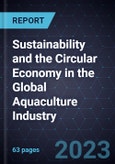Transformative Mega Trends Open the Way for Sustainable Growth
This report on global sustainability and the circular economy in the aquaculture industry analyzes the current and future growth potential of the aquaculture value chain from a sustainability point of view.
There is a growing demand for protein as the population expands, which will continue to rise as urbanization and income levels rise. An environmentally beneficial way to feed and provide the world's population with protein products is through aquaculture. The publisher estimates that the sustainability and circular economy in the global aquaculture industry was $1.70 billion in 2022 and is expected to register a 9.5% CAGR by 2030.
The rapid growth of the aquaculture market is driven by escalating global demand for seafood, a burgeoning population, and diminishing wild fish stocks. As traditional fishing methods struggle to meet these demands, the aquaculture sector has expanded to bridge the gap. However, this expansion presents ecological challenges, including water pollution, disease outbreaks, and habitat destruction.
The study covers a detailed analysis of the key markets - North America, Europe, the Asia-Pacific, Latin America, and the Middle East and Africa - and focuses on the following segments: sustainable feed (insects, organic fish feed, plant-based feeds), RAS and other treatment infrastructure (capital investment for water treatment solutions for aquaculture farms), biosolids and resource recovery (value-added processing and resource recovery), and IoT and digital solutions. This research service provides a qualitative and quantitative analysis of key sustainable aquaculture solutions.
Table of Contents
Companies Mentioned (Partial List)
A selection of companies mentioned in this report includes, but is not limited to:
- Aquabyte
- Atlantium
- BioFishency
- eFishery
- Entofood
- Fish Welfare Initiative (FWI)
- FRD Japan
- GEA
- Innovafeed
- Nutrition Technologies
- Skretting
- Veolia








